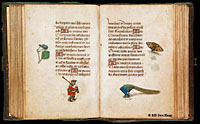
While manuscripts were gradually ousted by printed books in the rest of Europe towards the end of the 15th century, a last, major flowering of hand-written and opulently illuminated Books of Hours took place in the cities of Bruges and Ghent. A characteristic feature of the manuscripts produced in these towns are the borders in which separate branches and flowers seem to have been strewn on the coloured background, with added shading enhancing the illusionistic effect. Between the foliage birds, butterflies, insects, and strawberries have often been added, and occasionally even whole anecdotal scenes.
Within the manuscripts with these "Ghent-Bruges strewn borders" a special place is occupied by a set of some 15 Books of Hours that must originate from Bruges. In these books different elements from the strewn borders -- flowers, birds, but also drollery-like figures -- have been put individually on the white vellum without the usual coloured background, in such a way that whenever the book is open, four figures can be seen.
In the Hague Book of Hours belonging to this set we find in the margin different kinds of roses, columbines, violets, cornflowers, carnations, lilies, thistles, strawberries, and different kinds of birds, insects and small animals like martens, that make a deceptively lifelike impression because of the shadows they cast on the vellum. The pages reproduced here show a rosebud, a manikin playing a bagpipe, a long-tailed peacock picking the ground, and a butterfly. The beautiful, symmetrical lay-out and the sophisticated painting technique lend the pages a unique charm.